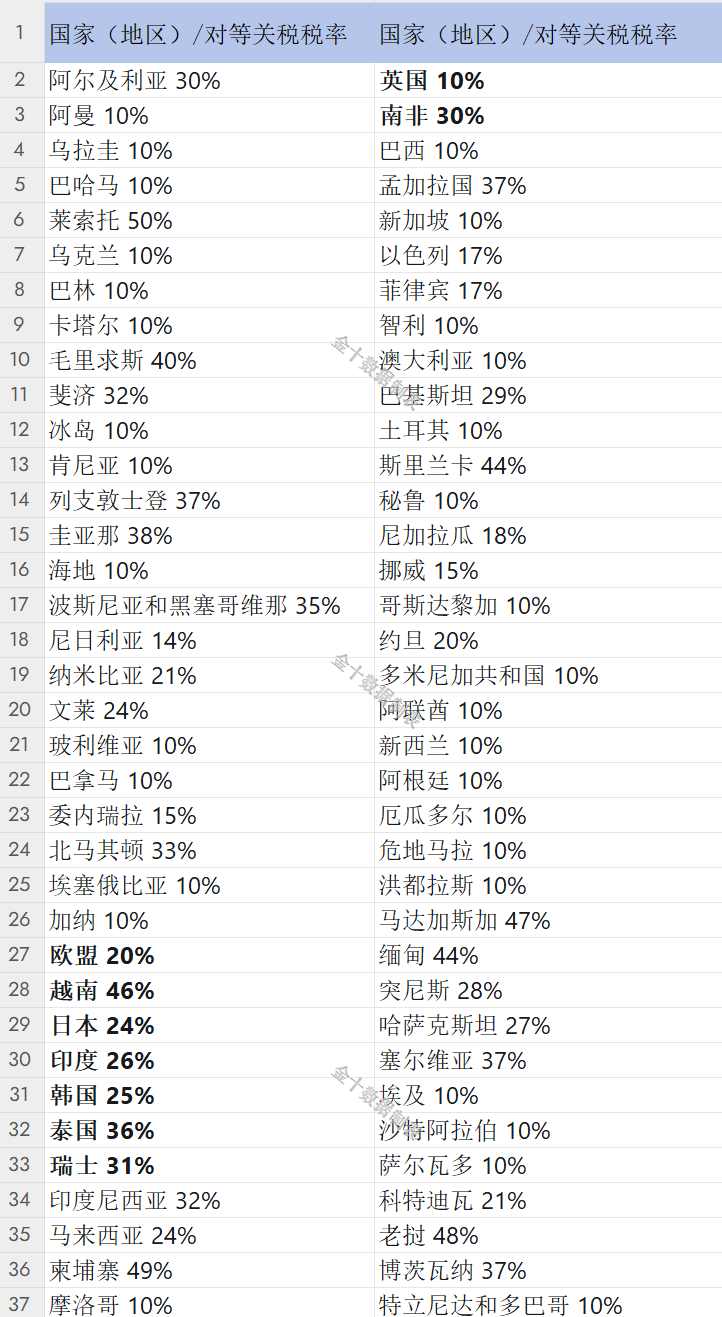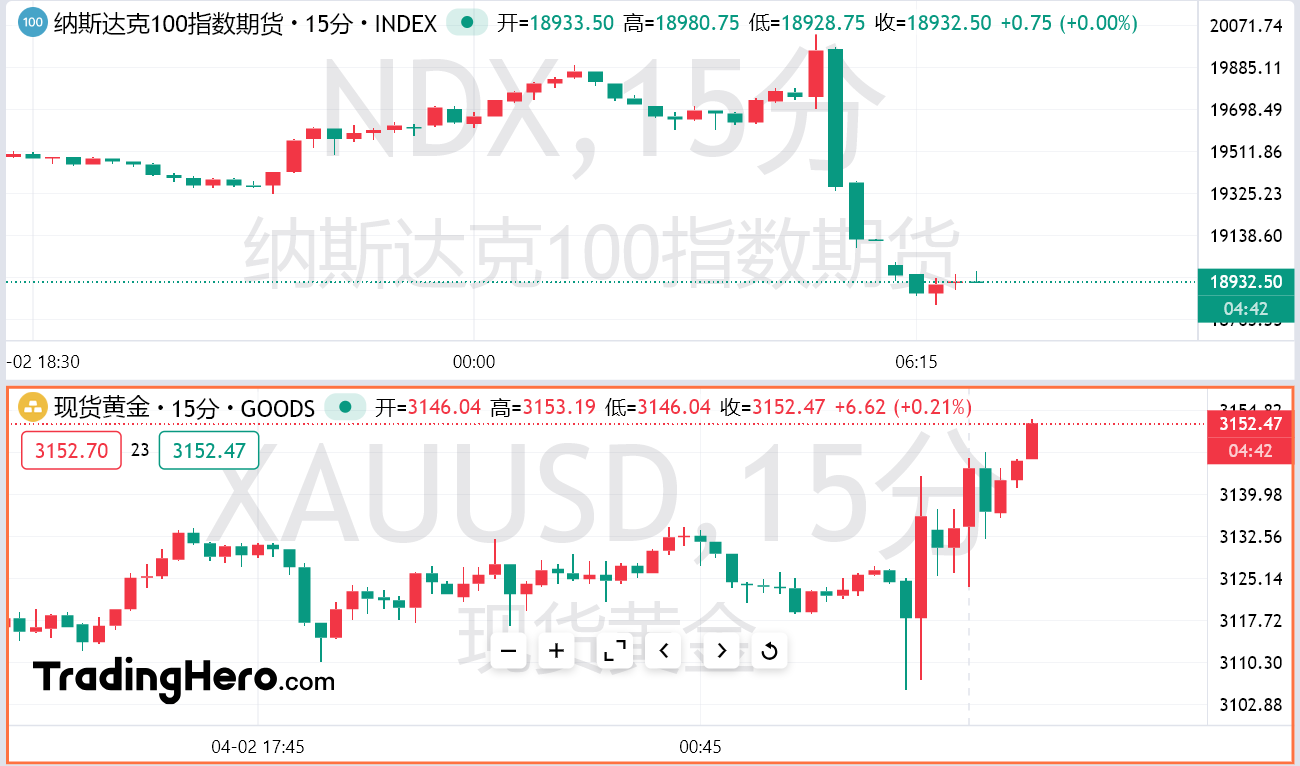Bessent urges countries not to take retaliatory actions, Wall Street is shocked, and spot gold breaks through 3150 to set a new high.
Author: Xiao Yanyan
Around 4 a.m. Beijing time on Thursday, U.S. President Trump delivered a speech in the White House Rose Garden. He stated that he would impose a minimum 10% tariff on all exporters to the U.S. and impose additional tariffs on about 60 countries/regions with the largest trade imbalances with the U.S. This marks his largest attack on the unfair global economic system he has long complained about.
Trump said, "For many years, hardworking American citizens have been forced to stand by while other countries have become wealthy and powerful, many at our expense. But now it is our turn to prosper."
The higher "reciprocal" tax rates set against the countries identified by the Trump administration as the most serious violators are based on the U.S. government's statistics on tariffs and non-tariff barriers imposed by these countries on U.S. goods. According to Trump's plan, countries facing higher, customized tax rates will be charged taxes equivalent to half of the calculated tax amount owed.
Trump stated, "Today is 'Liberation Day.' I will soon sign an executive order for reciprocal tariffs. Jobs and factories will return to America. Prices for consumers will be lower. For countries that are not good to us, we will calculate the total, including non-monetary barriers. Retaliatory tariffs will be half of their tariff rates, which will not be completely reciprocal. A 20% retaliatory tariff will be imposed on the EU by country. A 24% tariff will be imposed on goods imported from Japan."
According to senior White House officials, the baseline tariff rate (10%) will take effect at midnight on April 5, and reciprocal tariffs will take effect at midnight on April 9. Trump plans to impose additional industry tariffs on semiconductors, pharmaceuticals, and potential critical minerals that are not covered by the new tariffs. Trump will respond to retaliatory actions from other countries to ensure that the emergency order is not disrupted. Canada and Mexico are already facing a 25% tariff related to drug trafficking and illegal immigration; these tariffs will remain in effect as long as the separate tariffs are valid, and the two largest trading partners of the U.S. will not be affected by the new tariff regime. Exemptions for goods from Mexico and Canada that comply with the USMCA will continue.
"This is not complete reciprocity. This is a goodwill reciprocity," Trump said. Trump's tariff order does not include gold.

U.S. Partial Reciprocal Tariff Rates
White House documents show that some goods will not be subject to reciprocal tariffs, including: steel/aluminum products and automobiles/auto parts already subject to Section 232 tariffs; copper, pharmaceuticals, semiconductors, and wood products; all items that may be subject to Section 232 tariffs in the future; gold; energy and certain minerals that the U.S. cannot obtain.
Reuters' analysis of tariffs listed in the Federal Register shows that Trump's 25% auto tariff will expand to auto parts worth nearly $600 billion, covering cars, light trucks, engines, transmissions, lithium-ion batteries, and minor components such as tires, shock absorbers, and spark plug wires. The auto tariff will cover all computer imports, including laptops and desktops, with an import value of $138.5 billion in 2024.
Mary Lovely, a senior researcher at the Peterson Institute for International Economics, said the tariffs announced by Trump on Wednesday are "much worse than we feared." She noted that the specific implementation of the tariffs is still unclear and that "there will be a huge impact on the adjustment of global trade routes."
Trump stated that he would consider lowering the tax rates if other countries remove trade barriers on U.S. export products. "I say, terminate your own tariffs, abandon your barriers, and do not manipulate your currency," Trump said.
Trump declared a state of emergency related to the U.S. trade deficit, which exceeded $918 billion in goods and services in 2024, allowing him to use unilateral powers under the International Emergency Economic Powers Act to impose the broadest range of tariffs in generations. The government's goal is to revive U.S. manufacturing through a shift toward protectionism and to generate hundreds of billions of dollars in revenue from new taxes to replenish the government treasury.
Trump's move is a historic gamble that is expected to raise the costs of trillions of dollars worth of goods shipped from other countries to the U.S. each year. It could also trigger a global trade war marked by tit-for-tat strikes, disrupt supply chain stability, stimulate inflation, embolden U.S. economic competitors, and encourage foreign powers to form new alliances that exclude the U.S.
This situation presents a political problem for Trump: the economic losses from tariffs may come quickly, while any gains in the form of adjustments to the U.S. economic structure may take years or longer to materialize.
U.S. Treasury Secretary Bessent said, "I advise all countries not to take retaliatory actions. We can see if there will be (different from the announced figures) lower tariff limits. Trump's mindset may be to stabilize things temporarily. I am not involved in the negotiations; we will see if there are any negotiations before April 9 (the effective date of reciprocal tariffs)."
Market Reaction
Due to Trump's announcement of a comprehensive tariff rate of 10%, which is lower than market expectations, risk assets initially strengthened across the board but then fell back, with Nasdaq futures extending their decline to 4% in early trading on Thursday, and S&P 500 futures dropping over 3%. The dollar index briefly fell 50 points before rebounding, while Bitcoin surged over $1,500 before dropping, now at $83,000 per coin. Spot gold initially fell and then rose, setting a new historical high, breaking through $3,150 per ounce, with New York futures gold first touching $3,200 per ounce.

Wall Street traders were shocked. Strategists and fund managers are carefully studying the specific terms of the upcoming import taxes. With U.S. economic data already deteriorating, future trade negotiations are expected to be protracted, so the bearish rationale for risk assets remains in the short term.
Another viewpoint is completely opposite, arguing that further clarity in business policy will stimulate bargain hunters to rebuild risk exposure in the stock and credit markets.
Brian Jacobsen, chief economist at Annex Wealth Management, stated that the situation could have been worse, and framing the tariffs as "reciprocal" might prompt officials to negotiate quickly rather than take retaliatory actions. However, tariffs still come at a cost, either through rising consumer prices or declining profits. For investors, both are not good news. The market's reaction is reasonable, as the current question is how long these tariffs will last.
Michael O'Rourke, chief market strategist at JonesTrading, said, "This looks worse than the 20% plan. Given all the American products produced in Asia, these tariff rates of 20% to 34% are very high. This will lead to a slowdown in trade, rising prices, and squeezed profit margins. This will further slow down an already decelerating economy, as it will create friction and distortions in global trade. I think we need to expect retaliation—this is likely to lead to further escalation."
Matt Maley, chief market strategist at Miller Tabak + Co., said, "There hasn't been the kind of last-minute easing that some investors hoped for. So it seems the Trump administration is not worried about these tariff policies having a short-term impact on the market. This means that there will be intense focus on earnings guidance in the coming weeks. If earnings expectations continue to decline, it will pose greater resistance to the stock market."
Chris Zaccarelli, chief investment officer at Northlight Asset Management, said, "If there is a glimmer of hope—this remains to be seen—then hopefully these tariff rates are just the beginning of negotiations that will lead to a comprehensive reduction in rates."
Steve Chiavarone, head of multi-asset at Federated Hermes, stated, "If today's announcement marks the most severe level of tariffs—and from now on the news is about how countries negotiate to lower these rates, that could be favorable for the market. This could create enough selling over the next day or so to create a buying opportunity. The worst-case scenario today is low rates and escalation threats. At this point, I would prefer a higher rate that could potentially be downgraded."
Priya Misra, portfolio manager at J.P. Morgan Asset Management, said, "We have been welcoming 'Liberation Day' by holding quality credit and have been buying intermediate-term bonds to hedge against a slowdown in hard economic data. With Friday's non-farm payroll data about to be released, we will maintain this position. Tariffs present a stagflation pulse that will force the Fed to fall behind the curve. The economy and markets are facing many different headwinds, with growth facing downside risks: 1) tariffs (a tax imposed on consumers and/or businesses); 2) cuts in government spending through DOGE; 3) uncertainty. My biggest concern is uncertainty, which is affecting businesses and consumers. If the next few months or quarters are spent in trade negotiations, this uncertainty will remain high. I worry that some damage has already been done, so I am concerned about the impact on economic growth."
Ed Al-Hussainy, interest rate strategist at Columbia Threadneedle, said, "Clearly, this is a specific negative shock to the economy. It is clear that we must adequately price in the negative shock in advance. Ultimately, this is a tax—who will bear the cost of the tax is still uncertain, but I think you cannot view it as a measure that is beneficial to economic growth. In the short term, it is negative growth and positive inflation."
Dan Ives, head of global technology research at Wedbush, believes that the large-scale tariff measures introduced by Trump on Wednesday are worse for the market than expected. "We characterize this series of tariffs as 'worse than the worst-case scenario the market feared.'" He added that due to the impact of tariffs, tech stocks will face "significant" pressure, with investors anxious about demand destruction and supply chains. Concerns for Nvidia (NVDA.O) and other chip companies with significant supply chain ties will be about pricing and profit margins, as well as what this means for future global supply chains. Apple (AAPL.O) is also worth watching, as most of the company's iPhone production is done overseas.
免责声明:本文章仅代表作者个人观点,不代表本平台的立场和观点。本文章仅供信息分享,不构成对任何人的任何投资建议。用户与作者之间的任何争议,与本平台无关。如网页中刊载的文章或图片涉及侵权,请提供相关的权利证明和身份证明发送邮件到support@aicoin.com,本平台相关工作人员将会进行核查。




